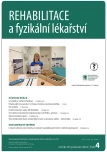Laryngocele and possibilities of treatment
Authors:
Vyskotová J. 1,2; Záthurecký- E. 2 4; Gottfriedová N. 2,3; Aláčová Gaul P. 1; Konečný P. 1; Mrázková- E. 2 4
Authors‘ workplace:
Ústav klinické rehabilitace, Fakulta zdravotnických věd, Univerzita Palackého v Olomouci
1; Centrum pro poruchy sluchu a rovnováhy, Klinika Versis, Ostrava-Poruba
2; Ústav epidemiologie a ochrany veřejného zdraví, Lékařská fakulta, Ostravská univerzita, Ostrava
3; Nemocnice Havířov, p. o.
4
Published in:
Rehabil. fyz. Lék., 29, 2022, No. 4, pp. 164-168.
Category:
Original Papers
doi:
https://doi.org/10.48095/ccrhfl2022164
Overview
Introduction: Laryngocele is a very rare disease resulting from an abnormal dilatation of the laryngeal saccule. It may be congenital or acquired after prolonged increased air pressure on the tissue. The vast majority of laryngocele cases are treated surgically; the course of the disease is very individual and the prognosis is highly dependent on the patient’s cooperation with their doctor and therapist. Aim: The aim is to present the case study of a patient with the laryngocele and the difficulties of diagnostics and treatment. Method: We present the case study of a 61-year-old miner and musician who plays the trumpet. In this specific patient, the laryngocele was surgically treated, with follow-up physiotherapy treatment. The authors describe the pre-surgery status of the voice analysis and the effect of post-surgery rehabilitation. Results: Objectively, a physiological endolaryngeal finding was demonstrated after the surgery, without recurrence of the disease, the results of voice analysis objectively improved after the surgery and physiotherapy intervention.
Keywords:
voice training – laryngocele – laryngeal diseases – dysphonia – voice disorders – voice analysis
Sources
1. Dhaha M, Jbali S, Dhambri S et al. Laryngocele after subtotal laryngectomy. Iran J Otorhinolaryngol 2018; 30(100): 305–308.
2. Vasileiadis I, Kapetanakis S, Petousis A et al. Internal laryngopyocele as a cause of acute airway obstruction: an extremely rare case and review of the literature. Acta Otorhinolaryngol Ital 2012; 32(1): 58–62.
3. Marom T, Roth Y, Cinamon U. Laryngocele: a rare long-term complication following neck surgery? J Voice 2011; 25(3): 272–274. doi: 10.1016/j.jvoice.2010.01.011.
4. Kiricsi Á, Fazekas P, Nagy A et al. Surgical treatment of laryngocele. Orv Hetil 2019; 160(31): 1235–1240. doi: 10.1556/650.2019.31447.
5. Koeller KK, Alamo L, Adair CF et al. Congenital cystic masses of the neck: radiologic-pathologic correlation. Radiographics 1999; 19(1): 121–146. doi: 10.1148/radiographics.19.1.g99ja06121.
6. De Paula Felix JA, Felix F, Pires de Mello LF. Laryngocele: a cause of upper airway obstruction. Braz J Otorhinolaryngol 2008; 74(1): 143–146. doi: 10.1016/s1808-8694(15)30765-5.
7. Upile T, Jerjes W, Sipaul F et al. Laryngocele: a rare complication of surgical tracheostomy. BMC Surg 2006; 6(1): 14. doi: 10.1186/1471-2482-6-14.
8. Dursun G, Ozgursoy OB, Beton S et al. Current diagnosis and treatment of laryngocele in adults. Otolaryngol Head Neck Surg 2007; 136(2): 211–215. doi: 10.1016/j.otohns.2006.09.008.
9. Keles E, Alpay HC, Orhan I et al. Combined laryngocele: a cause of stridor and cervical swelling. Auris Nasus Larynx 2010; 37(1): 117–120. doi: 10.1016/j.anl.2009.02.011.
10. Zelenik K, Stanikova L, Smatanova K et al. Treatment of laryngoceles: what is the progress over the last two decades? Biomed Res Int 2014; 819453. doi: 10.1155/2014/819453.
11. Araz O, Turan A, Yoruk, O et al. Laryngocele and epiglottis cyst as rare cause of obstructive sleep apnea. Sleep Breath 2009; 13(3): 285–287. doi: 10.1007/s11325-009-0250-x.
12. Suqati AA, Alherabi AZ, Marglani OA et al. Bilateral combined laryngocele. Saudi Med J 2016; 37(8): 902–904. doi: 10.15537/smj.2016.8.15104.
13. Szwarc BJ, Kashima HK. Endoscopic management of a combined laryngocele. Ann Otol Rhinol Laryngol 1997; 106(7): 556–559. doi: 10.1177/000348949710600704.
14. Szymanowski AR, Fechtner L, Muscarella J. Endoscopic excision of a large combined laryngocele. Ear Nose Throat J 2020; 99(5): 50–51. doi: 10.1177/0145561319840142.
15. Thomé R, Thomé DC, De la Cortina RA. Lateral thyrotomy approach on the paraglottic space for laryngocele resection. Laryngoscope 2000; 110(3): 447–450. doi: 10.1097/00005537-200003000-00023.
16. Ciabatti PG, Buralli G, D’Ascanio L. Transoral robotic surgery for large mixed laryngocoele. J Laryngol Otol 2013; 127(4): 435–437. doi: 10.1017/S0022215113000236.
17. Patel KB, Lin C, Kramer S et al. Transoral robotic excision of laryngocele: surgical considerations. Head Neck 2019; 41(4): 1140–1143. doi: 10.1002/hed.25612.
18. Kerekrétiová A. Terapie poruch hlasu. In: Lechta V. et al. Terapie narušené komunikační schopnosti. Praha: Portál 2005: 127–165.
19. Gangale DC. Rehabilitace orofaciální oblasti. Praha: Grada 2004.
20. Prasad KC, Vijayalakshmi S, Prasad SC. Laryngoceles – presentations and management. Indian J Otolaryngol Head Neck Surg 2008; 60(4): 303–308. doi: 10.1007/s12070-008-0108-8.
21. Holinger LD, Barnes DR, Smid LJ et al. Laryngocele and saccular cysts. Ann Otol 1978; 87(5): 675–685. doi: 10.1177/000348947808700513.
Labels
Physiotherapist, university degree Rehabilitation Sports medicineArticle was published in
Rehabilitation & Physical Medicine

2022 Issue 4
Most read in this issue
- KISS syndrome
- Relaxation of shortened muscles in children by scootering
- Fine motor skills assessment limitations in selected standardized tests – perspective of occupational therapists
- Laryngocele and possibilities of treatment
